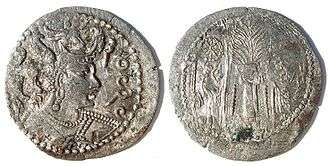Napki Malka
Nēzak Shāh (Middle Persian: nycky MLK) was a Nezak king of the late 5th-century, and possibly the founder of a dynasty bearing the same name. On his coins, his name appears in Pahlavi script as "nycky MLK".[1][2][3] He was ruling in the area of Kabul, modern Afghanistan. His coins are rather numerous and characteristic of the Kabul region, and have also been found in Buddhist stupas and monasteries in Taxila.[4]
| Nēzak Shāh | |
|---|---|
| King | |
Nezak king Nēzak Shāh. British Museum. | |
| Reign | 6th-7th century |
| Dynasty | Nezak Huns |
| Religion | Buddhism |
His coins have been found in association with the Sasanian king Khusrau I in a hoard, suggesting possible contemporaneity.[1]
In 557, the Hephthalites were crushed by a coalition of Turks led by a certain Sinbiju, or Sinzibul, and Sasanians, under their king Khusrau I. After their defeat, their land was divided between the two victors along the line of the Oxus.[1]
Later, during the Arab invasions of the 7th century, remaining communities of Hephthalites, under a certain Tarkhan Nezak, are said to have staunchly resisted the invaders.[1] An alternative reading of Napki Malka's name on his coins has been suggested by Harmatta, which would be Nycky MLK, Nycky being the usual transcription of "Nezak" in Persian, thereby suggesting a possible identity between Napki Malka and Tarkhan Nezak, or the preservation of the "Napki Malka" title down to the last Hephthalite rulers.[1]
A temple appears on the back of the coins of Nēzak Shāh, and has been interpreted as a depiction of the temple of Jabal Zur for the worship of Shuna, a possible instance of sun-worshipping before the arrival of Islam.[5]
On his coins, Nēzak Shāh wears a characteristic winged headdress, surmounted by a bull's head.
Notes
- Bailey, Harold (29 April 1983). The Cambridge History of Iran, Volume 3: The Seleucid, Parthian and Sasanid Periods. Cambridge University Press. p. 215. ISBN 978-0-521-20092-9.
- Frye, Richard (1974). "Napki Malka and the Kushano-Sasanians". In Near Eastern Numismatics, Iconography, Epigraphy and History: Studies in Honor of George C. Miles, ed. Dikran K. Kouymjian: 115–22.
- Harmatta, János (1969). "Late Bactrian Inscriptions". Acta. 17: 297–432.
- Taxila, Volume 2. Cambridge University Press. p. 834.
- Pata Khazana (translated by Kushal Habibi) (30 April 1997). Hidden Treasure. University Press of American. p. 166. ISBN 978-0-7618-0265-5.
External links
![]()
